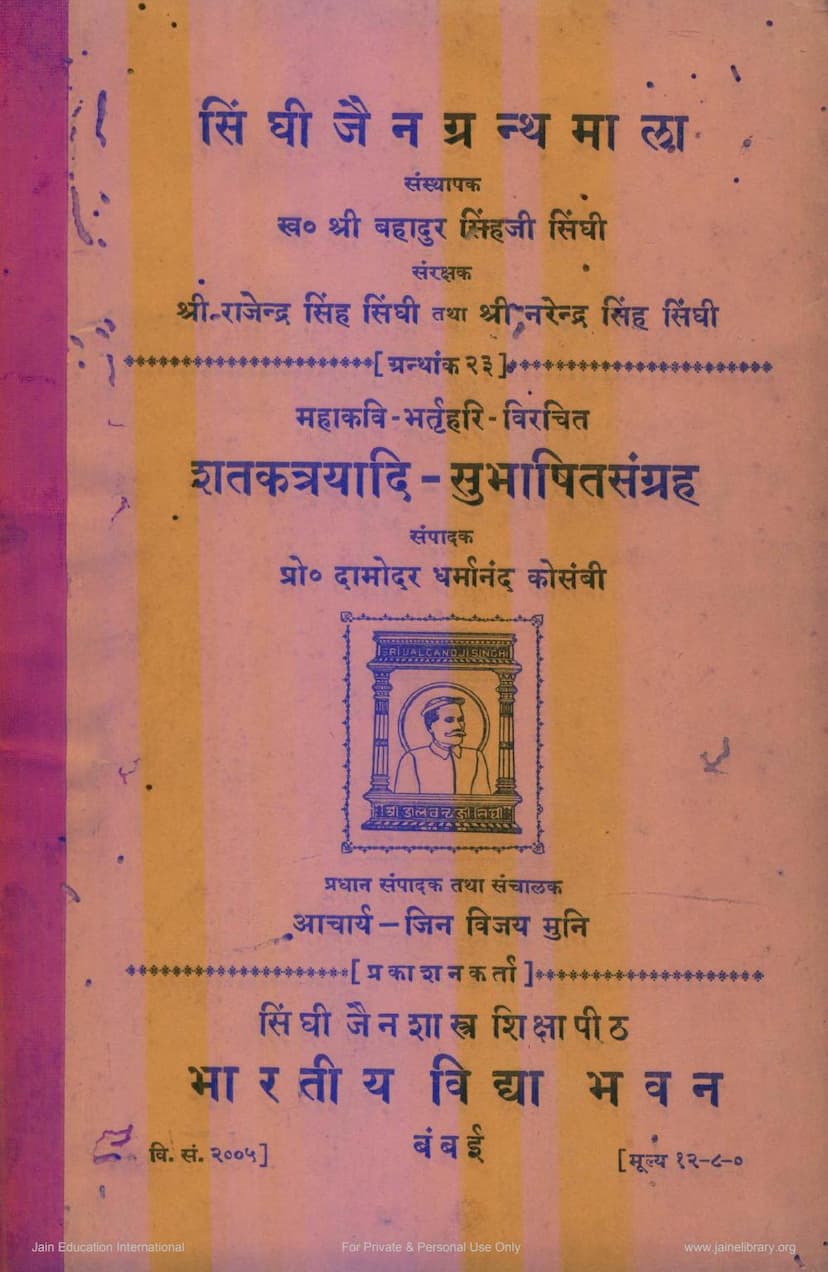Shataka Trayadi Subhashit Sangraha
Added to library: September 2, 2025

Summary
Here's a comprehensive summary of the Jain text "Shataka Trayadi Subhashit Sangraha" (A Collection of Fine Sayings from the Three Centuries) by Bhartṛhari, edited by Prof. Damodar Dharmanand Kosambi, published by Bharatiya Vidya Bhavan:
Overview:
This book is a critical scholarly edition of the "Śatakadvaya" (meaning "two centuries") or "Śatakatraya" (meaning "three centuries") attributed to the renowned poet Bhartṛhari. The work is a compilation of epigrams, or fine sayings, divided into three thematic centuries: the Nītiśataka (on policy and ethics), the Śṛṅgāraśataka (on love and eroticism), and the Vairāgyaśataka (on detachment and renunciation). The edition by D.D. Kosambi is significant for its extensive collection and critical analysis of numerous manuscripts, aiming to establish the most authentic text.
Key Aspects of the Edition:
- Critical Edition: The primary goal of this publication is to present a critical edition of Bhartṛhari's epigrams. This involves collecting evidence from hundreds of manuscripts, comparing different readings (variants), and establishing the most likely original text.
- Manuscript Collection: Professor Kosambi undertook a monumental task of gathering a vast number of manuscripts, both in original and copied forms, from various libraries and private collections across India and potentially beyond. The preface and introduction detail the methods of this collection and the challenges involved.
- Textual Analysis and Grouping: The edition meticulously analyzes the collected manuscripts, identifying different recensions (Northern and Southern) and versions within them. This analysis is crucial for understanding the transmission and evolution of Bhartṛhari's poems. The book includes a synoptic chart to illustrate the relationships and variations among major manuscript versions.
- Bhartṛhari's Identity: The work also delves into the historical identification of Bhartṛhari himself, examining various traditions and legends that associate the poems with different historical figures (grammarian, king, ascetic). However, the edition acknowledges the ambiguity and lack of definitive proof for any single identification, relying on internal evidence from the verses themselves.
- Three Centuries: The collection is organized into the three recognized centuries:
- Nītiśataka: Focuses on ethical conduct, worldly wisdom, principles of governance, and the consequences of actions.
- Śṛṅgāraśataka: Explores the nuances of love, desire, the complexities of relationships, and the experiences of sensuous pleasure.
- Vairāgyaśataka: Deals with themes of detachment, the transient nature of worldly possessions, the vanity of life, and the pursuit of spiritual liberation.
- Apparatus Criticus: The edition includes a detailed critical apparatus, indicating the readings from various manuscripts, explaining the methods for determining the text, and highlighting significant variants and omissions.
- Foreword and Prefaces: The book features a foreword by Acharya Jinavijaya Muni, who expresses deep appreciation for Prof. Kosambi's scholarly work and his father's legacy. Kosambi's own preface explains the genesis of the project, the immense challenges faced in manuscript collection and textual criticism, and the unique methodology employed.
- Jain Scholarly Context: The publication is part of the "Singhi Jain Granthamala" series, established in memory of Seth Sri Dālchandji Singhi and his son Bahadur Singhji Singhi, who were patrons of Jain literature and culture. This highlights the significant role Jain traditions played in preserving and transmitting Bhartṛhari's works, as evidenced by the presence of numerous manuscripts in Jain Bhandars and early commentaries by Jain scholars.
Significance:
This edition by D.D. Kosambi is a landmark contribution to Sanskrit scholarship. It not only makes Bhartṛhari's universally admired verses accessible in a critically edited form but also provides invaluable insights into the history of textual transmission, manuscript studies, and the intermingling of different cultural and religious traditions in ancient and medieval India, particularly the Jain tradition's contribution to Indian literature. The work is a testament to the rigorous application of critical methods, even to a subject outside Kosambi's primary field of mathematics.